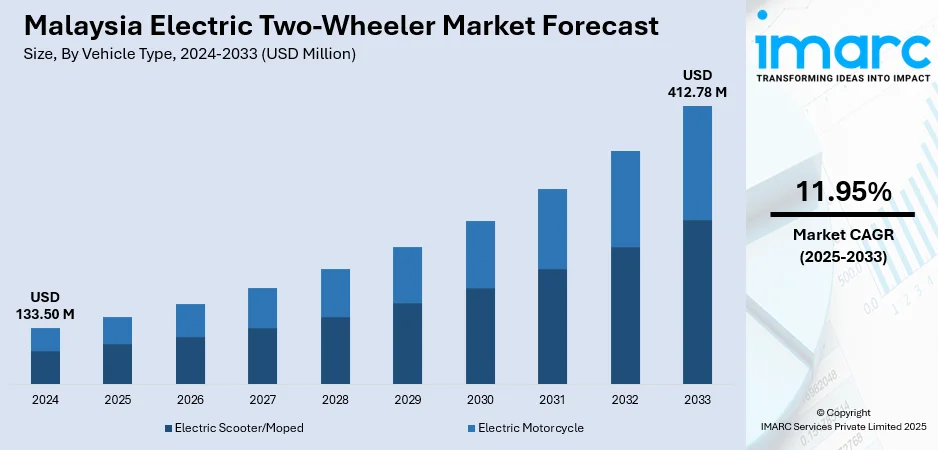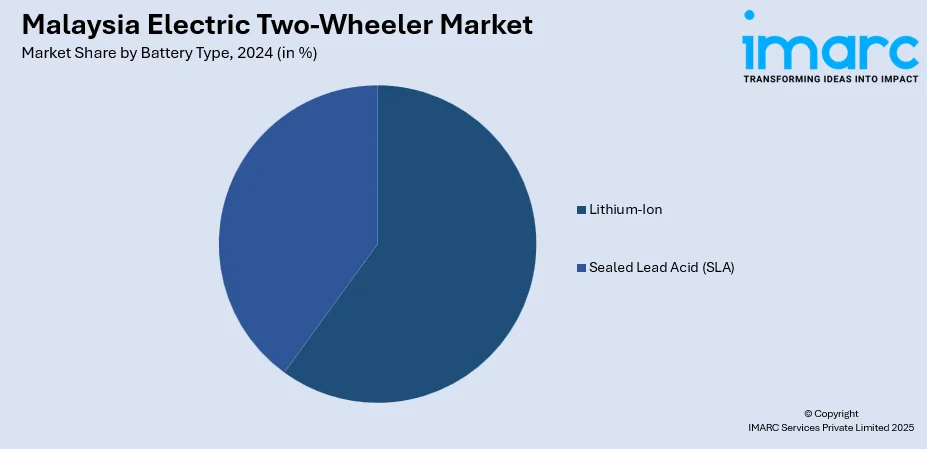
Malaysia Electric Two-Wheeler Market Size, Share, Trends and Forecast by Vehicle Type, Battery Type, Voltage Type, Peak Power, Battery Technology, Motor Placement, and Region, 2025-2033
Malaysia Electric Two-Wheeler Market Overview:
The Malaysia electric two-wheeler market size reached USD 133.50 Million in 2024. The market is projected to reach USD 412.78 Million by 2033, exhibiting a growth rate (CAGR) of 11.95% during 2025-2033. The market is driven by rising fuel costs, government incentives promoting electric mobility, and growing environmental awareness among consumers. Increasing urban congestion and demand for affordable, efficient transport further boost adoption. Advances in battery technology, expanding charging infrastructure, and entry of new players offering competitively priced models enhance market appeal. Additionally, supportive policies under Malaysia’s Low Carbon Mobility Blueprint and growing investment in electric vehicle (EV) ecosystems encourage both manufacturers and consumers to shift toward electric two-wheelers, accelerating Malaysia electric two-wheeler market share.
|
Report Attribute
|
Key Statistics
|
|---|---|
|
Base Year
|
2024
|
|
Forecast Years
|
2025-2033
|
|
Historical Years
|
2019-2024
|
| Market Size in 2024 | USD 133.50 Million |
| Market Forecast in 2033 | USD 412.78 Million |
| Market Growth Rate 2025-2033 | 11.95% |
Malaysia Electric Two-Wheeler Market Trends:
Rising Fuel Prices and Cost Efficiency
One of the primary drivers of Malaysia electric two-wheeler market trends is the continuous rise in fuel prices, which significantly impacts commuting costs for daily riders. Electric two-wheelers offer a cost-efficient alternative with lower operating and maintenance expenses compared to traditional motorcycles. This cost advantage is especially attractive to urban commuters, delivery service providers, and small business operators who rely heavily on two-wheelers for daily operations. With electricity being much cheaper than petrol, users experience substantial long-term savings, making electric scooters and bikes more appealing. The growing awareness of these economic benefits is encouraging consumers to consider EVs as practical replacements for conventional motorcycles. Furthermore, the availability of government incentives, such as reduced road tax for EVs, enhances affordability and encourages adoption. Thus, rising fuel costs coupled with cost efficiency are accelerating the shift toward electric two-wheelers in Malaysia.

To get more information on this market, Request Sample
Government Initiatives and Policy Support
The Malaysian government plays a crucial role in boosting the electric two-wheeler market through supportive policies and incentives. Under frameworks such as the Low Carbon Mobility Blueprint (2021–2030) and the National Automotive Policy (NAP 2020), Malaysia aims to reduce carbon emissions and encourage electric vehicle adoption. Incentives like tax exemptions, rebates, and reduced road taxes for electric vehicles make e-scooters and e-bikes more affordable and attainable to the public. Additionally, investments are being directed toward expanding EV infrastructure, including charging stations, which directly supports two-wheeler users. The government also encourages local manufacturing and assembly of EVs, fostering a more robust supply chain. These initiatives not only lower ownership costs but also strengthen consumer confidence in transitioning from traditional motorcycles to electric alternatives. Consequently, policy support remains a major driver for the Malaysia electric two-wheeler market growth and long-term sustainability.
Urbanization, Traffic Congestion, and Delivery Services
Rapid urbanization in Malaysian cities like Kuala Lumpur, Penang, and Johor Bahru has intensified traffic congestion, making electric two-wheelers an increasingly attractive mobility solution. These vehicles are compact, easy to maneuver, and ideal for short-distance commuting, addressing urban mobility challenges effectively. Additionally, the rapid growth of e-commerce and food delivery services is fueling demand for affordable, efficient, and reliable transport options. Delivery riders particularly favor electric two-wheelers for their low operating costs, reduced downtime, and zero tailpipe emissions, aligning with growing environmental awareness among urban populations. Supporting this shift, the government’s MARiiCas rebate scheme has accelerated adoption—by June 2024, 3,664 rebate applications were approved, distributing RM 8.79 million in incentives, with sales in just six months surpassing the total e-bike sales of the previous five years. This momentum underscores electric two-wheelers’ role in driving sustainable urban mobility in Malaysia.
Malaysia Electric Two-Wheeler Market Segmentation:
IMARC Group provides an analysis of the key trends in each segment of the market, along with forecasts at the country and regional levels for 2025-2033. Our report has categorized the market based on vehicle type, battery type, voltage type, peak power, battery technology, and motor placement.
Vehicle Type Insights:
- Electric Scooter/Moped
- Electric Motorcycle
The report has provided a detailed breakup and analysis of the market based on the vehicle type. This includes electric scooter/moped, and electric motorcycle.
Battery Type Insights:

- Lithium-Ion
- Sealed Lead Acid (SLA)
A detailed breakup and analysis of the market based on the battery type have also been provided in the report. This includes lithium-ion, and sealed lead acid (SLA).
Voltage Type Insights:
- <48V
- 48-60V
- 61-72V
- 73-96V
- >96V
A detailed breakup and analysis of the market based on the voltage type have also been provided in the report. This includes <48V, 48-60V, 61-72V, 73-96V, and >96V.
Peak Power Insights:
- <3 kW
- 3-6 kW
- 7-10 kW
- >10 kW
A detailed breakup and analysis of the market based on the peak power have also been provided in the report. This includes <3 kW, 3-6 kW, 7-10 kW, and >10 kW.
Battery Technology Insights:
- Removable
- Non-Removable
A detailed breakup and analysis of the market based on the battery technology have also been provided in the report. This includes removable, and non-removable.
Motor Placement Insights:
- Hub Type
- Chassis Mounted
A detailed breakup and analysis of the market based on the motor placement have also been provided in the report. This includes hub type, and chassis mounted.
Regional Insights:
- Selangor
- W.P. Kuala Lumpur
- Johor
- Sarawak
- Others
The report has also provided a comprehensive analysis of all the major regional markets, which include Selangor, W.P. Kuala Lumpur, Johor, Sarawak, and others.
Competitive Landscape:
The market research report has also provided a comprehensive analysis of the competitive landscape. Competitive analysis such as market structure, key player positioning, top winning strategies, competitive dashboard, and company evaluation quadrant has been covered in the report. Also, detailed profiles of all major companies have been provided.
Malaysia Electric Two-Wheeler Market News:
- In May 2025, PETRONAS Dagangan Berhad and Blueshark Ecosystem Sdn. Bhd. launched Blueshark Malaysia Sdn. Bhd., a joint venture to drive nationwide adoption of electric two-wheelers and smart mobility solutions. The venture will exclusively distribute Blueshark e-bikes, expand battery-swapping stations at PETRONAS outlets, and enable local assembly through EP Manufacturing Bhd. This collaboration supports Malaysia’s National Energy Transition Roadmap, combining PETRONAS’s retail network, Blueshark’s innovation, and advanced EV technologies for scalable growth.
Malaysia Electric Two-Wheeler Market Report Coverage:
| Report Features | Details |
|---|---|
| Base Year of the Analysis | 2024 |
| Historical Period | 2019-2024 |
| Forecast Period | 2025-2033 |
| Units | Million USD |
| Scope of the Report |
Exploration of Historical Trends and Market Outlook, Industry Catalysts and Challenges, Segment-Wise Historical and Future Market Assessment:
|
| Vehicle Types Covered | Electric Scooter/Moped, Electric Motorcycle |
| Battery Types Covered | Lithium-Ion, Sealed Lead Acid (SLA) |
| Voltage Types Covered | <48V, 48-60V, 61-72V, 73-96V, >96V |
| Peak Powers Covered | <3 kW, 3-6 kW, 7-10 kW, >10 kW |
| Battery Technologies Covered | Removable, Non-Removable |
| Motor Placements Covered | Hub Type, Chassis Mounted |
| Regions Covered | Selangor, W.P. Kuala Lumpur, Johor, Sarawak, Others |
| Customization Scope | 10% Free Customization |
| Post-Sale Analyst Support | 10-12 Weeks |
| Delivery Format | PDF and Excel through Email (We can also provide the editable version of the report in PPT/Word format on special request) |
Key Questions Answered in This Report:
- How has the Malaysia electric two-wheeler market performed so far and how will it perform in the coming years?
- What is the breakup of the Malaysia electric two-wheeler market on the basis of vehicle type?
- What is the breakup of the Malaysia electric two-wheeler market on the basis of battery type?
- What is the breakup of the Malaysia electric two-wheeler market on the basis of voltage type?
- What is the breakup of the Malaysia electric two-wheeler market on the basis of peak power?
- What is the breakup of the Malaysia electric two-wheeler market on the basis of battery technology?
- What is the breakup of the Malaysia electric two-wheeler market on the basis of motor placement?
- What is the breakup of the Malaysia electric two-wheeler market on the basis of region?
- What are the various stages in the value chain of the Malaysia electric two-wheeler market?
- What are the key driving factors and challenges in the Malaysia electric two-wheeler market?
- What is the structure of the Malaysia electric two-wheeler market and who are the key players?
- What is the degree of competition in the Malaysia electric two-wheeler market?
Key Benefits for Stakeholders:
- IMARC’s industry report offers a comprehensive quantitative analysis of various market segments, historical and current market trends, market forecasts, and dynamics of the Malaysia electric two-wheeler market from 2019-2033.
- The research report provides the latest information on the market drivers, challenges, and opportunities in the Malaysia electric two-wheeler market.
- Porter's five forces analysis assist stakeholders in assessing the impact of new entrants, competitive rivalry, supplier power, buyer power, and the threat of substitution. It helps stakeholders to analyze the level of competition within the Malaysia electric two-wheeler industry and its attractiveness.
- Competitive landscape allows stakeholders to understand their competitive environment and provides an insight into the current positions of key players in the market.
Need more help?
- Speak to our experienced analysts for insights on the current market scenarios.
- Include additional segments and countries to customize the report as per your requirement.
- Gain an unparalleled competitive advantage in your domain by understanding how to utilize the report and positively impacting your operations and revenue.
- For further assistance, please connect with our analysts.
 Request Customization
Request Customization
 Speak to an Analyst
Speak to an Analyst
 Request Brochure
Request Brochure
 Inquire Before Buying
Inquire Before Buying




.webp)




.webp)












